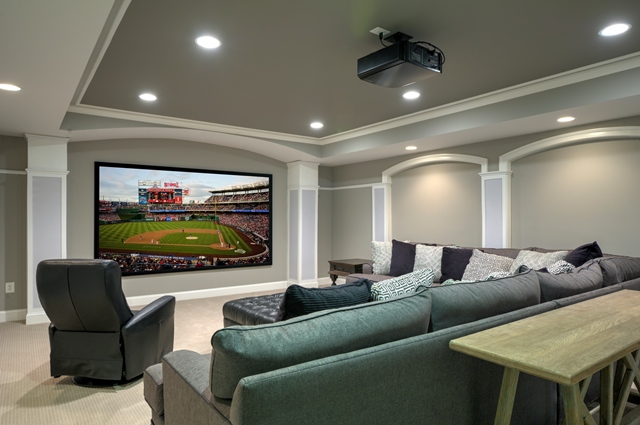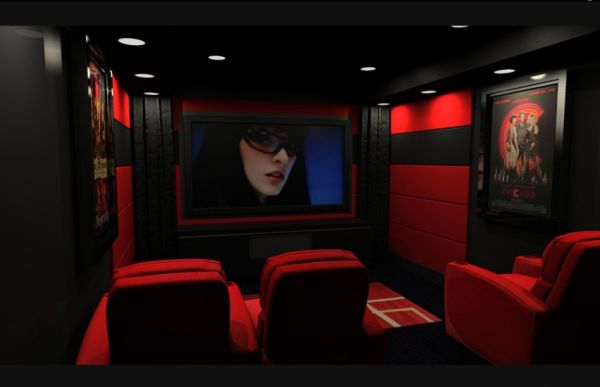A movie hideaway could be a comfortable room with your favorite chair, sofa or seating, a television, and storage for all of your DVDs. Or it could be something far more sophisticated; a room purpose-built or transformed into a home theater, customized to account for the acoustics, and to provide the ultimate viewing experience.
Home theater: The ideal space for a home theater is 20 feet by 13 feet, and a room adapted for this purpose will require special insulation. This could be standard or even soundproof drywall, or ordinary drywall lined with high-density vinyl to dampen the sound, and a solid door for sound reduction. The ideal screen size for a room this size is 110 to 120 inches. The room could be pre-wired with a 7.1 surround sound system; this includes a speaker above or below the viewing screen, one either side of the screen at ear height, two on the side walls just behind the main row of seating, and two speakers on the back wall – 9.1 surround sound adds another set of speakers in the front of the room. Other considerations for a serious, purpose-built home theater could include:

- Speakers hidden behind acoustic panels.
- A pre-wired video projector for a large-screen experience, with a HDMI cable and a CAT5 control wire so that the projector can be accessed with a radio-frequency remote.
- Recessed lighting in the ceiling, and sconces on the side walls connected to a radio-frequency dimmer, which are set to auto-dim when you press play.
- Low-voltage floor lighting for stadium seating, which can be left on at all times.
- A back row with a pre-built platform so that the seats are elevated.
- Comfortable seats in easy-to-clean fabric, with cup holders in the armrests.
- A fridge and a popcorn machine.
Movie hideaway: If a home theater isn’t practical, film fans can still create a dedicated area for movie-watching in any room in the house. What you put into your movie hideaway really depends on the size of the room and your budget. Nowadays, DVDs are not your only option for watching films, and you will need the internet to stream films or media to your various playback devices over the network. A Blu-ray player can stream high-definition movies off the internet, as well as play discs, and some also network with your PC so that you can enjoy your music and photos as well.

The viewing distance from a HDTV should be about one to one-and-a-half times the width of the television screen, so aim to be about five feet away from a 50-inch Plasma or LCD HDTV to optimize your viewing experience. Ideally, the screen should not be directly opposite a window because of the light reflection. Windows will need blackout curtains, or fit shutters on the windows. A range of shutters are available that provide a more economical and a better aesthetic result to your home.
If you intend to transform a room into a home theater from scratch, professional advice should be sought. However, more affordable technology and improved resources mean that more and more people are adapting a room into their very own movie hideaway for a comfortable and very effective movie experience.























